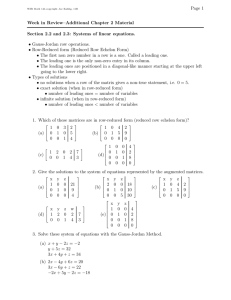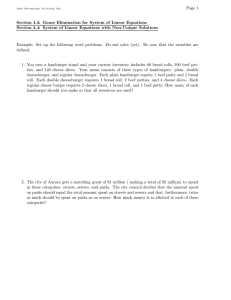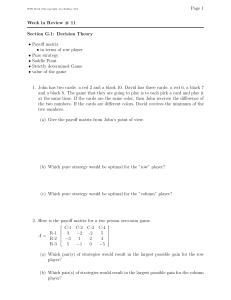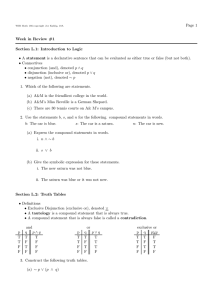Page 1 Week in Review # 8 • Setting up word problems.
advertisement
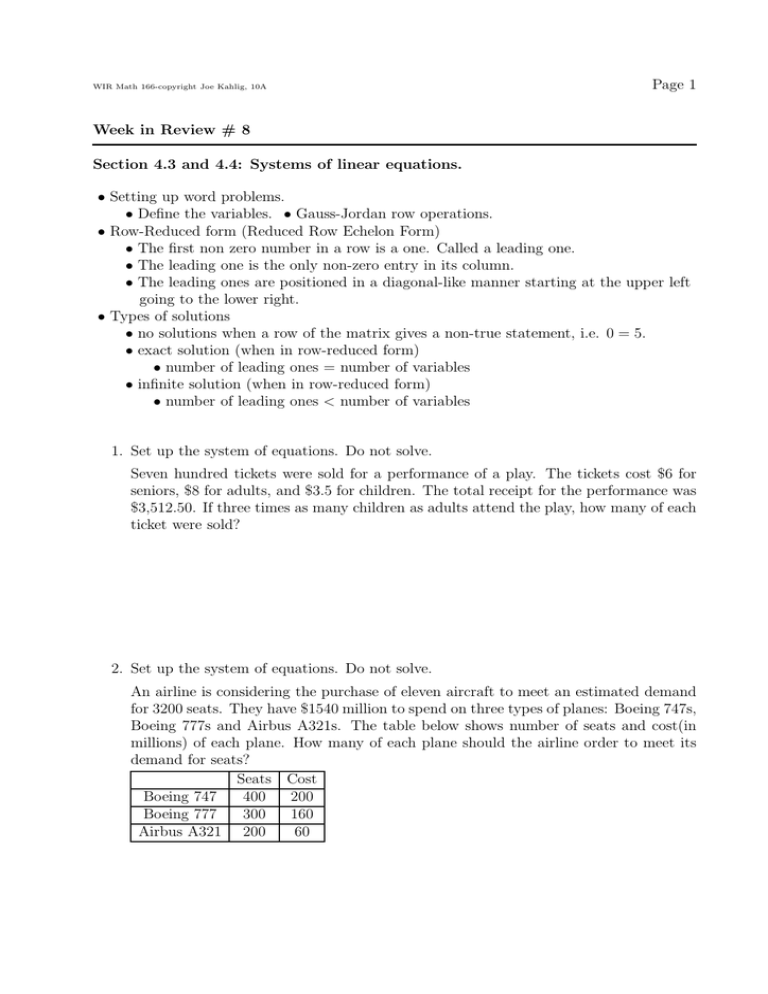
WIR Math 166-copyright Joe Kahlig, 10A Page 1 Week in Review # 8 Section 4.3 and 4.4: Systems of linear equations. • Setting up word problems. • Define the variables. • Gauss-Jordan row operations. • Row-Reduced form (Reduced Row Echelon Form) • The first non zero number in a row is a one. Called a leading one. • The leading one is the only non-zero entry in its column. • The leading ones are positioned in a diagonal-like manner starting at the upper left going to the lower right. • Types of solutions • no solutions when a row of the matrix gives a non-true statement, i.e. 0 = 5. • exact solution (when in row-reduced form) • number of leading ones = number of variables • infinite solution (when in row-reduced form) • number of leading ones < number of variables 1. Set up the system of equations. Do not solve. Seven hundred tickets were sold for a performance of a play. The tickets cost $6 for seniors, $8 for adults, and $3.5 for children. The total receipt for the performance was $3,512.50. If three times as many children as adults attend the play, how many of each ticket were sold? 2. Set up the system of equations. Do not solve. An airline is considering the purchase of eleven aircraft to meet an estimated demand for 3200 seats. They have $1540 million to spend on three types of planes: Boeing 747s, Boeing 777s and Airbus A321s. The table below shows number of seats and cost(in millions) of each plane. How many of each plane should the airline order to meet its demand for seats? Seats Cost Boeing 747 400 200 Boeing 777 300 160 Airbus A321 200 60 Page 2 WIR Math 166-copyright Joe Kahlig, 10A 3. Set up the system of equations. Do not solve. Bob has $82,000 that he wants to invest in the stock market and in bonds. Due to the volatility of the stock market, he has divided the stocks into two categories: low-risk stocks and high-risk stocks. Bob has decided that the amount invested in high-risk stocks should equal the amount invested in low-risk stocks and bonds combined. Bob estimates that the bonds will have a dividend rate of 4%/year; low-risk stocks will have a rate of return of 8%/year; and high-risk stocks will have a rate of return of 15%/year. How much money should Bob invested in each category, if he wants to have a return of $9050/year on the total investment? 4. Give the solutions to the system of equations represented by the augmented matrices. x y z 1 0 0 0 1 0 0 0 0 x y z 1 0 4 2 0 1 5 9 0 0 0 0 (a) (c) (e) x y z 1 0 0 0 1 0 0 0 1 0 0 0 21 9 4 4 2 8 0 (b) x y z 2 0 0 18 0 1 0 10 0 0 5 30 x y z (d) 1 2 0 0 0 1 w 2 7 4 3 WIR Math 166-copyright Joe Kahlig, 10A Page 3 5. Perform the row operations that get a zero in the row 2 column 1 position and the row 3 column 1 position. 1 −5 4 0 9 2 1 2 −3 12 3 8 6. Perform the indicated row operations and give the resulting matrix. 1 2 7 11 2 4 0 5 (−11)R1 + (2)R2 → R1 5 3 39 25 5 4 5R3 + (−4)R4 → R3 6 1 7. Solve these systems of equations by any method. (a) 3x + y = 9 x+z =4+y z − 11 = −3x 4x + 6y + 2z = 15 + 7y (b) x + 3y + z = 10 2x + 7y − z = 21 4x + 13y + z = 41 (c) 3x + 2y + 5z = 7 x + 4y + z = 13 4x − 5y + 2z = −9 5x + 10y + 7z = 32 WIR Math 166-copyright Joe Kahlig, 10A Page 4 8. Bob has budgeted $840 to expand his video library with 60 DVDs. His local video store prices their DVDs at $10 for an old release, $16 for a semi-new release, and $22 for a current release. How many DVDs from each category will Bob be able to buy assuming that he uses all of the budgeted money? (a) Set up and solve the word problem. If the solution is infinite, then place restrictions on the parameter. (b) How many different solutions are there for this word problem? Page 5 WIR Math 166-copyright Joe Kahlig, 10A Section 5.1: Introduction to Matrices • dimension(size) row x columns • aij is the entry in row i and column j • scalar product of a matrix • transpose of a matrix, denoted AT • addition/subtraction of matrices • must be the same dimension. • if the matrix has a variable in it, then you must do the computation by hand. A= " 7 2 4 6 5 0 # B= " 9 −1 3 2 0 8 # 1 C = −2 2 9. Compute the following with the matrices listed above. (a) 3d2,2 + 2c2,1 = (b) 3A = (c) C T = (d) A + 2B = (e) 3A − 4B = (f) 6A − 2B + 3C = (g) 5C − 2AT = 3 5 0 D= " x 1 2 5 # Page 6 WIR Math 166-copyright Joe Kahlig, 10A 10. Solve for x and y. 4 " 6 y 2x 5 # − " 5 3y 18 10 # = " 19 −28 x 10 #T
